Q&A – Ask Neil: May 2, 2024
(Please read these instructions carefully.)
Before you post your question, please look at recent issues to see if someone else has already asked it. You might find your answer there.
How to submit your question…
(Note: You may need to allow a pop-up window to come up in order to get the link for sending your photo(s). If you have already submitted your question and didn’t see the pop-up window, please click here.)
• Click the link provided below to post your question. After you submit your question, a new window will pop up giving you the address to which you can e-mail a SHARP, HIGH-RESOLUTION PHOTO to accompany your question. Please DO NOT SEND THUMBNAIL PHOTOS in case I need to zoom in to see things.
• Click here to post your question.
• Please ONLY POST YOUR QUESTION ONE TIME. We can only accept a set number of questions each week, and when we get duplicates it costs other people their chances.
• One question per reader, please.
• Please use this only for posting questions – not for standard emails.
• Watch for your answer in the following week’s e-gardens.
• I choose those of greatest general interest. For example, plant IDs seldom make the cut.
• I must have your first name or initials.
• I must have your city or county. (Texas is a very large state.)
QUESTION 1
HOW CAN I LURE JUNE BUGS AWAY FROM OUR PATIO?
Question: June bugs! I cannot enjoy an evening on my patio without getting pelted by these annoying beetles. Then, in the morning, they are all over my patio and lawn. Any idea of how I can lure them away from people and trap them somewhere else? Travis B., Branch, Collin County.
Answer: They will run their course within a couple of weeks. You might be able to get some to come to lights away from the patio, but if I’m accurately remembering my experiences helping an entomologist back in the 1970s study them, primarily males are attracted to the lights. Females will be out in the lawn laying their eggs. Because you’re so far north in Texas and it’s so early in the June beetle season where you are, this is not the species that causes the widespread damage to turf. Other than the temporary annoyance, there probably isn’t much about which you should be concerned.
QUESTION 2
SHOULD I USE “HULLED” OR “UNHULLED” BERMUDAGRASS SEED?
Question: I am going to plant bermuda seed to replace St. Augustine killed by chinch bugs last summer. Should I use hulled or non-hulled seed? What are the pros and cons of each type? William T., Waco.
Answer: I’m assuming this is in your lawn. If so, use hulled (hulls removed) seeds. You’ll get quicker, more uniform germination. Sow at the rate of 2-4 pounds per 1,000 square feet. Unhulled seed is better for rough-use areas where you would have difficulty getting irrigation to the germinating seeds. They all won’t sprout at the same time. Enough of the unhulled seeds will wait on rain.
QUESTION 3
WHAT IS DEVOURING MY BUTTERFLY WEED?
Question: What is this pest that is devouring my butterfly weed? Claudia S., Corpus Christi.
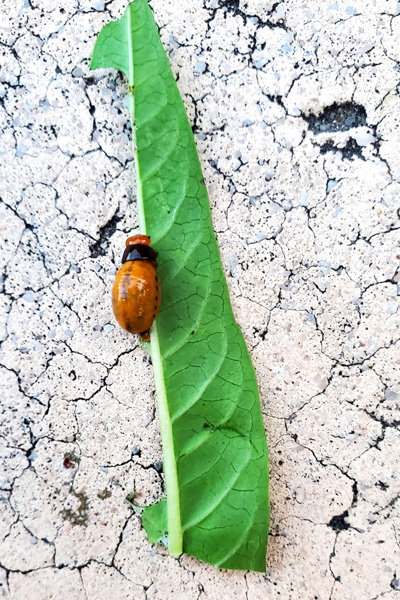
Answer: I’m a horticulturist, not an entomologist. I may have caught the wrong ship out of Corpus Christi, but I believe this is a pupa of a ladybird beetle (ladybug). Aphids are common on butterfly weeds, and ladybugs are fond of aphids. So, if a horticulturist’s assumption is correct, that explains this living being.
Going on to my second leap of faith, my guess would be that there was a caterpillar (that’s why they’re called “butterfly” weeds) that did the actual feeding. In fact, maybe you were lucky enough to have been visited by a caterpillar of a monarch butterfly – the reason so many of us plant this and other milkweeds.
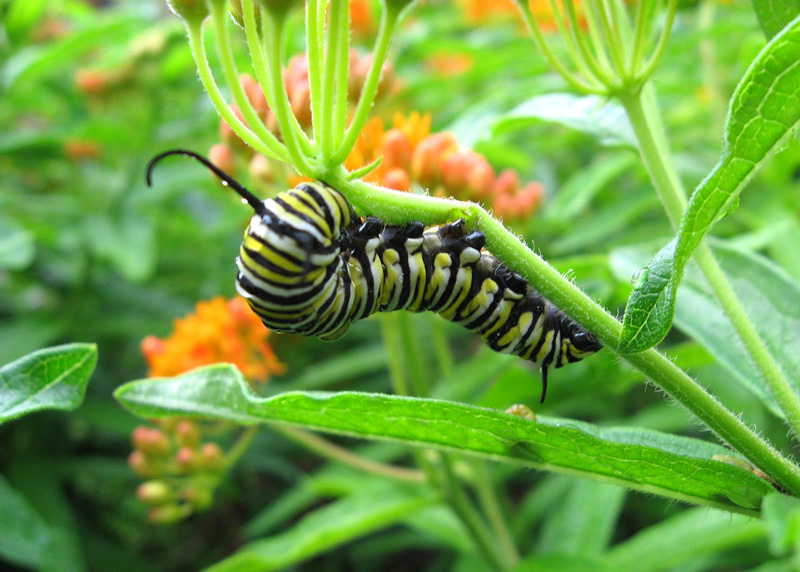
Here is a link that shows the development of ladybird beetles from eggs to adults. Your photo seems to fall between the last two stages. https://www.thoughtco.com/the-life-cycle-of-ladybugs-1968141.
All of which is to say, I think your butterfly weed’s problems are behind it, and they may not have been serious problems at all.
QUESTION 4
WHAT IS THE FERTILIZATION SCHEDULE FOR ST. AUGUSTINE SOD LAID THIS MONTH?
Question: What is the type of fertilizer and schedule we should use for St. Augustine sod we will lay in May 2024? Melinda A., Frisco.
Answer: For the Blackland Prairie where you live you will want to use an all-nitrogen fertilizer with 30 to 40 percent of that nitrogen in encapsulated or coated slow-release form. That will be the ongoing recommendation probably for many years and it should serve you quite well this first year.
Mow your new grass at 2 to 2-1/2 inches and start mowing as soon as it takes root and starts to grow vigorously – probably within the first couple of weeks. After you mow it the second time, fertilize it at half the recommended rate using the fertilizer I described. Water the fertilizer into the top couple of inches of soil immediately after feeding.
Wait one month (no later than mid-June) and fertilize it at the recommended rate on the bag. Of course, you must always water following feeding. Then wait until early September to feed it again. We overfeed St. Augustine in many cases, especially in the heat of the summer, and that can lead to outbreaks of gray leaf spot fungus. Starting next year, I would fertilize it in mid-April, early June, and early September.
QUESTION 5
HOW CAN WE CONTROL YAUPON HOLLIES WITHOUT HARMING OUR LAWN AND POST OAKS?
Question: We are having a terrible time with what appear to be yaupons coming up and invading our St. Augustine lawn. I am unsure how to control the yaupons without harming the lawn and our native post oak trees. Help! Tonya R., Southlake.
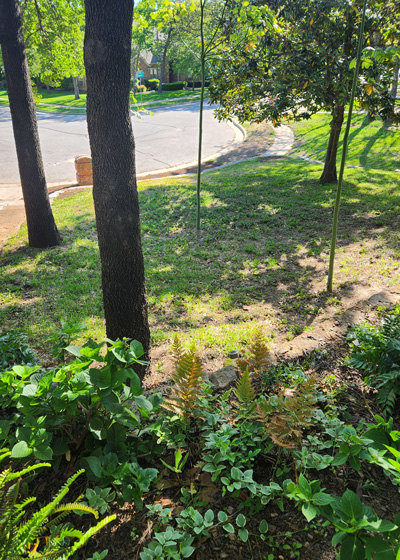
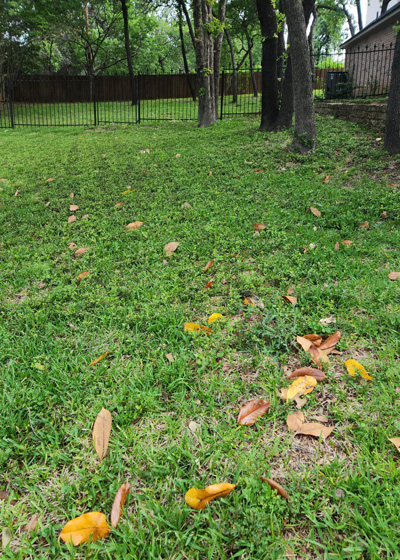
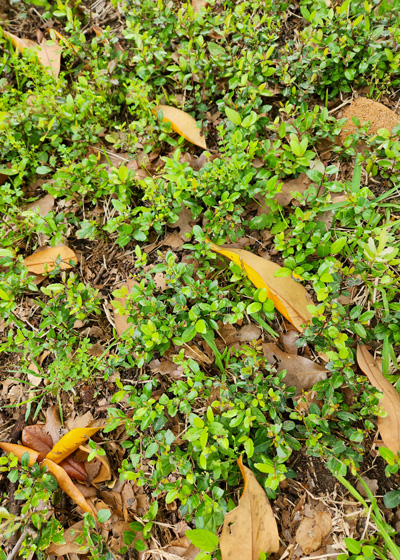
Answer: This is one of the most puzzling questions I’ve received in a long time. I grew up where yaupon hollies are densely native (College Station), so I’m familiar with how they can look as they get started. But they are not native anywhere within 100 miles of Tarrant County and I couldn’t see any mature plants that could have borne fruit in your photos. Even if there had been, I’ve never seen such a huge population of young seedlings. I guess we can assume they came from a plant elsewhere in your landscape or from a neighbor’s garden.
All of which doesn’t matter. I’ve just never seen that many seedlings. The means of controlling them would be the same. Mechanical removal (pulling, hoe, or shovel) would be completely impractical, and mowing might eventually discourage them, but I fear they would become very stubbly before they finally gave up. The grass is sparse enough due to shade that the yaupons will hold their own for a good while.
That leaves us with the use of a suitable herbicide as perhaps the best option. If it were my landscape, I’d probably do a trial with a 2,4-D broadleafed weedkiller applied at a time when the yaupons were growing the most vigorously (probably now). That herbicide is usually sold in tandem with two other herbicides and it carries two warnings that will scare you. One is that it must be applied in cooler weather, and the other that it should not be applied beneath trees.
You’ll have more leeway with a product containing only 2,4-D, and such products do exist. I would try one of those on a small part of the yard to see if you are satisfied with the results – perhaps the size of a card table. Give it two or three weeks to check for kill of the yaupons and no damage to the St. Augustine.
In looking at your photos I can see how much work you’re putting into your landscape and lawn. I fear that there isn’t enough sunshine hitting the ground for the lawngrass to thrive. St. Augustine is our most shade-tolerant grass, so if you ultimately decide that turf isn’t the solution, you may opt to switch over to a groundcover once you eliminate the mysterious yaupon invaders.
Addendum: In editing your photos to size I just noticed what I thought were two green bamboo stakes in the left photo. Two varnish trees (Firmiana simplex). Oh, the shade you are going to have! St. Augustine is going to be a goner.
QUESTION 6
HOW CAN I DEAL WITH THIS DROP-OFF?
Question: Is it possible to fill in this edge with soil without ruining the grass? Olga G-O, Collin County.
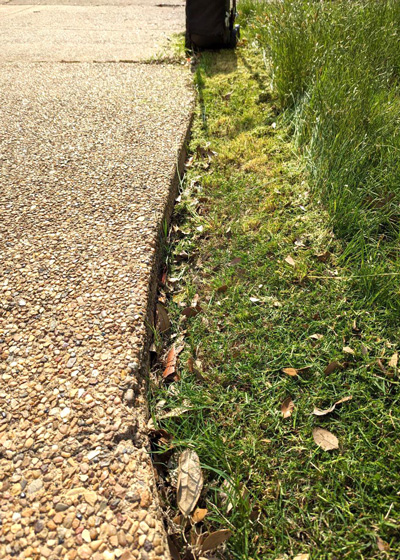
Answer: That’s not safe, so it’s understandable that you would want to fill it in. But just adding a narrow ramp of topsoil along that edge wouldn’t make it much safer. It still would be a source of stumbles. You really need to taper it way back into the lawn by several feet so it’s not an abrupt hill. I don’t know what your permanent lawngrass is, but if you have bermudagrass in there, it will quickly cover back as the winter grasses die in late May’s warm weather. Fertilize to encourage more rapid cover and plant a few pieces of sod if needed.
QUESTION 7
HOW DO I PRUNE MY BIGLEAF HYDRANGEAS?
Question: Our bigleaf hydrangea has old stems with both foliage and dead wood. I know they bloom on old wood, so I’ve been reluctant to do any pruning. How should I trim them? David Y., Rowlett.
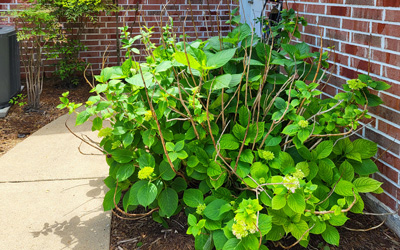
Answer: You are correct that they bloom on growth they made the prior year. However, if those stems die back in the winter they might as well be pruned out early in the spring as new growth emerges. You can reach down into the plants with shears now and carefully cut them out one stalk at a time. If you have a stem with a few weak shoots, go ahead and remove it as well. Your plants will end up looking much better.
To answer two unasked questions:
First, your hydrangeas are beginning to show iron chlorosis, as noted by the yellowed leaves with dark green veins. You need to apply an iron additive with sulfur soil acidifier to correct that issue but be very careful not to get the iron product on brick or concrete or you will be left with rust-colored stains.
Second, the nandinas by your air conditioner would benefit from being cut completely to the ground and allowed to regrow from their bases, if not now, at least in January next year. That kind of dramatic cutting yields great results when a nandina gets extremely leggy. (Never cut them back “part way.” They don’t branch out like other plants do.)
